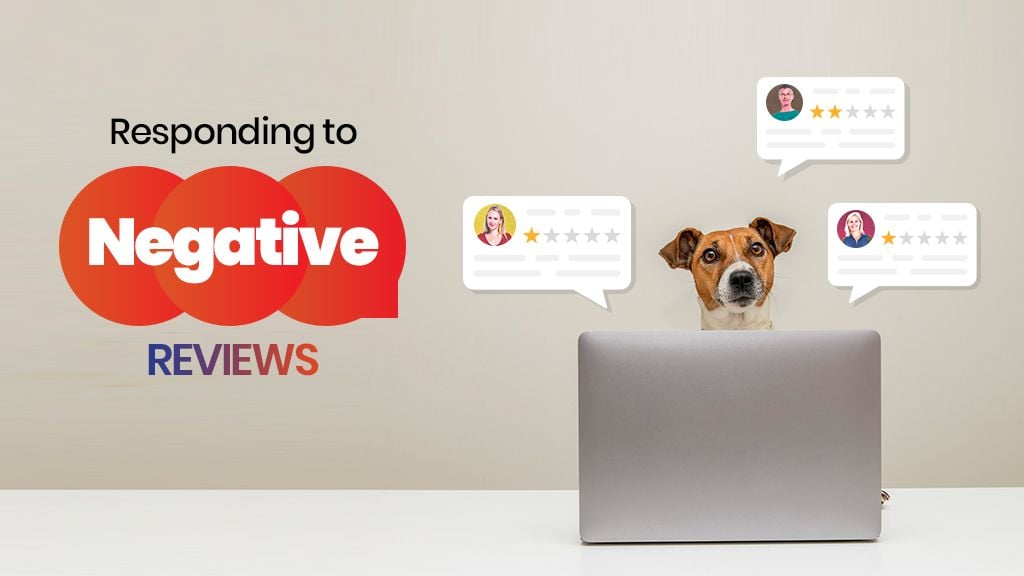13 Most Common Negative Reviews for Vets and How to Respond
)
The current climate is the toughest it has ever been for Australian vets.
Uncertainty, urgency, an influx of pet owners, and a shortage of staff. Sound familiar?
Even at the best of times, negative reviews can be left by disgruntled clients. It’s tough to swallow when you put your heart and soul into your veterinary clinic and provide excellent service to every set of paws that come through your doors.
More than that, Google Reviews affect your website score (ranking) as to whether your business shows up when clients try to find a business like yours.
Why your vet practice is getting negative reviews:
You try your hardest to be the best vet clinic that you can be. But negative reviews are inevitable so don’t take them to heart.
Even the best vets get bad reviews.
So, whether you’ve logged onto your clinic’s Facebook page or Google business listing and see a low star review...
To get automated notifications, set them up in Google and Facebook.
Don’t panic!
Responding to negative feedback on your vet clinic is easy. And, if you do it right...
You can even turn a bad situation into a good one.
Should you respond to negative reviews?
Yes, you should always respond to negative reviews because it shows that you're concerned and that you want to improve your service.
You shouldn't ignore negative reviews because responding to bad reviews helps to
- Show clients you care about them and their pets
- Show clients you want to keep your service at a high standard
- Make your clinic look professional
What to say to negative reviews
It’s a bit harder for vets to respond to bad feedback because you’re servicing a treasured member of their family. It’s not as simple as taking food back to the kitchen and remaking it, and so, your response is critical.
The best steps for vets to respond to negative reviews
Respond and do it early (but take a breath before replying if you are upset, and come back a few hours later)
Acknowledge the issue
Offer an explanation
Apologise and have sympathy
Don't use canned responses - personalise your response
Don't get personal
Respond publicly then take it offline
Don't ask them to delete
Follow up directly or privately
Don’t ignore criticism. Instead, objectively look at the criticism from the patient’s point of view and determine whether there is something you or your office can do differently.
Don’t shy away from online reviews. Ask your patients to rate and review you online. In most cases, reviews are positive. And remember that many positive reviews dilute many negative reviews.
Don't talk about the patient and the case. (That is an offline conversation).
Say Thank You
Bad reviews hurt and can even be just a list of exaggerations and half-truths written in anger. Whatever happened, this person took the time to share their experience, so the best way to start a response is acknowledging the effort it took to write the review. Here are some ways to do it: " Thank you for taking the time to share your experience" Thanks you for the feedback"
All reviews should be replied to, as that makes the person who did the review feel good, and it reflects positively on your practice.
Use your practice manager or reception team to reply to the positive ones, and the negative ones you answer.
What to do when your vet gets a negative review (steps to respond)
Respond quickly
Time isn’t just money. It’s valuable minutes and hours you could be spending making pets feel better. Responding to bad reviews can put a dampener on your day and be a hassle to take the time out for, but the more often you do it, the easier it gets.
From managing vet social feeds, we’ve found that the faster the response, the easier it is to have it solved. You should respond to negative comments and reviews within 24 hours for the easiest solution. Any longer than that, and clients could have contacted other vets, posted on other platforms, and escalated problems for your clinic.
Working in a clinic, it’s rare to have a chance to stop and scroll through Facebook (if you don't have your notifications set up - see above). So, set some time out of your day (maybe 30 minutes before you close, or at home) to respond to positive and negative reviews.
Acknowledge the complaint
You’ve poured hours into building your clinic, and you’re proud of it. That’s why, sometimes, it’s hard to put pride aside and acknowledge a complaint.
But as hard as it is to admit, not everyone is likely to leave 100% happy even with your best efforts. Mistakes and accidents happen, appointments can run late, staff can call in sick, and services can suffer.
Showing your empathy and understanding to reviewers goes a long way in getting their problems solved and getting more positive feedback. Some of the best phrases to show compassion when responding to poor reviews include:
“We’re sorry to hear you had a bad experience.”
“It’s unfortunate that you feel you had a bad experience with us.”
Apologise and empathise
Now that you’ve acknowledged the client’s issue, it’s time to apologise (if you’re in the wrong).
Here are some example apology responses for vet reviews:
“We apologise for the inconvenience to you and (pet’s name).”
“We apologise that our service wasn’t up to scratch for you and (pet’s name)”
Should you apologise to reviews if it isn’t your fault?

Yes, but also, no. Instead of apologising for poor service or similar, apologise for not meeting their expectations and wish them the best in finding a service that can.
Provide a brief explanation
The purpose of explaining events in review responses is to highlight why an event may have happened and provide a backstory to other readers. In doing so, it’s less likely to look like negligence and more likely to show your personality to clients and encourage them to see you on a closer level.
When explaining why the event happened, try the following:
Don’t justify your actions to defend yourself. Explain the events apologetically. (The detail of queries should be done offline)
Offer alternatives or explain what you’ll do in future to prevent it from happening again.
If they have been a client, you have their contact details to talk about it privately.
Public grievances are rarely good PR for vet clinics. To avoid public back and forth with clients and escalating problems, ask the reviewer for their preferred method of communication and reach out to find a solution.
The most common negative reviews for vets, and how to respond (with examples and responses):
No explanation
As annoying as it is, it happens. Extend your contact details to the reviewer and ask them for feedback so you can help them.
A client accidentally chose 1 star instead of 5 for their review

How annoying! Does this count as a negative review? According to Google and the SEO team at SEJ, it does.
Start by expressing gratitude for their positive feedback on the service they received. Instead of demanding any changes, kindly address any misunderstandings and offer clarification or additional information if needed. Encourage them to consider your response and update their review accordingly. Remember, fostering open communication and understanding is key to resolving issues and maintaining a positive reputation.
If they don’t read your response, laugh about it next time they’re in your clinic (lightly highlighting why reviews are important for your vet clinic).
A client didn’t get to see the veterinarian that they wanted to see:
Acknowledge their desire to see a specific veterinarian and apologise for any inconvenience caused. Assure them that all veterinarians at your practice are highly skilled and dedicated to providing exceptional care. Offer to address their concerns personally and suggest scheduling a follow-up appointment with their preferred veterinarian, if available. By demonstrating your willingness to listen and accommodate their needs, you can help turn their negative experience into a positive one and maintain their trust in your practice.
Long waiting times, or appointment availability:
Apologise for any inconvenience caused and assure them that you take their concerns seriously. Share information about any measures being taken to improve waiting times or enhance appointment availability, such as expanding staff or implementing scheduling enhancements. Offer solutions like online appointment booking or extended hours to provide more flexibility. Reiterate your commitment to delivering high-quality care and assure them that you value their time. By addressing their concerns and demonstrating a proactive approach to resolving the issue, you can help rebuild their trust in your practice.
The client claims that a member of staff was rude
Begin by expressing appreciation for their feedback and assure them that providing excellent customer service is a top priority for your practice. Apologise sincerely for their negative experience and acknowledge that rudeness is unacceptable. Provide your contact details to take the matter offline. Reaffirm your commitment to providing exceptional service and emphasise that their feedback is valued in helping you continuously improve.
The client claims that services and medications are too expensive
Explain that providing high-quality veterinary care requires experienced professionals, advanced equipment, and safe medications, which contribute to the overall cost. And unfortunately pet medication is not subsidised. However, assure them that you strive to offer competitive pricing and value for the services provided. Consider mentioning any cost-saving options or payment plans available, such as wellness packages or discounts for multiple pets. By demonstrating understanding and offering alternatives, you can address their concerns and show your commitment to delivering exceptional care at a fair value.
Made-up or false reviews from a client
When encountering a made-up or false review from a client, it's essential to handle the situation carefully and professionally. Begin by expressing appreciation for their feedback while politely noting that you have no record or recollection of their specific experience. Avoid engaging in a confrontational or accusatory tone. Instead, kindly ask them to provide more details or contact your practice directly to discuss their concerns further.
If the made-up review is particularly negative and you can’t risk having it public, you could contact your platform’s customer support.
If your veterinary website is managed by Vet Marketing Services, contact us, and we’ll help to organise a solution asap.
Fake reviews from the competition, other vets leaving fake reviews
Business can be sour- even in the vet world.
First, you need to be certain that another vet has left a negative review. Then, you can contact your platform provider (Facebook, Google, Instagram) to have the review investigated and removed.
“My pet is still sick after seeing the vet”
This one is a bit trickier because of potential legal implications- but it’s not impossible. Begin by expressing gratitude for their feedback and understanding their frustration. Apologise for the continued illness of their pet and assure them that their pet's health is of utmost importance to your practice. Offer to reevaluate the situation and schedule a follow-up appointment to reassess the pet's condition.
Respond to the client by:
Thank them for taking the time to leave the review so you can improve your service
Ask the client to privately send their contact information through so you can book them an appointment as soon as possible.
Responding to a negative grooming service review
Begin by expressing gratitude for their feedback and apologising for any dissatisfaction they experienced with the grooming service. Assure them that providing exceptional grooming experiences is important to your practice. Offer to discuss their specific concerns privately to gather more details about their experience and to better understand their expectations.
If your feedback on grooming is usually positive, consider acknowledging this: "We appreciate all feedback from our clients, and it's worth noting that the majority of feedback we receive about our grooming services is overwhelmingly positive."
Link your best before and after photos for the client, and any other reader of the review- turning the negative review into a positive advertisement for your service and evidence of your amazing work.
A pet has reacted poorly to treatment or medication
Explain to the client that like humans, pets have different reactions to medications and treatments.
Apologise for any distress caused and assure them that their feedback is taken seriously. Encourage the client to contact your practice directly to discuss the matter further, allowing for a more detailed understanding of the situation. Offer to review the treatment plan, consult with other veterinarians if necessary, and provide alternative solutions or adjustments to the medication if appropriate.
Offer another booking time to help get their pet feeling 100%.
If your website has a blog (which it should), you can direct them to your helpful tips and advice articles for additional information.
Your stock levels are always low on pet food
If you’re like many Australian vets and sell pet food in-clinic, sometimes an unexpected surge in purchases can lead to low stock levels. Unfortunately, it’s impossible to predict sometimes and it happens. To respond:
Apologise for being low on stock and explain that the food is really popular (highlight why it’s popular and why you choose to recommend and sell it).
Offer to assist the client personally by checking stock availability in advance or providing recommendations for alternative products.
Long phone wait times
Begin by expressing appreciation for their feedback and apologise for any frustration they experienced due to the extended wait times. Explain that managing phone calls can sometimes be challenging, especially during peak hours, but assure them that you take their concerns seriously and are actively working on solutions to reduce wait times. Share any measures you are implementing, such as hiring additional staff or implementing call management systems, to improve efficiency and responsiveness. Offer alternative contact methods, such as email or through your website, as options to potentially alleviate the issue. Reiterate your commitment to providing excellent service and assure them that you value their time and feedback.
Was the bad review response you wanted not here?
Reach out to us between Monday to Friday 9 am to 4.30 pm at (07) 5636 3766 and let us know your situation. We’ll put our heads together to come up with the best-written response and then, we’ll add it to this list to help other vets in future.
Should you respond to good reviews as a vet?

That is a big YES!
Reviews are important for your clinic and a great way to encourage more is to engage with your clients. They have taken time out to write the review - so it is important that you take the time out to thank them.
Keeping a positive online presence and maintaining a high star-rating
The best way to maintain a positive relationship with clients and a great presence online is to get a little bit of help from the experts.
Vet Marketing Services works exclusively with Australian vets and understands the industry. We put careful thought and attention into every website, newsletter, social media post, and blog that we help our clients with.
And like you, we want to help provide the best possible service to your clients.
Call us for a chat at (07) 5636 3766, or contact us online.
| Tags:WebsiteSocial Media |




